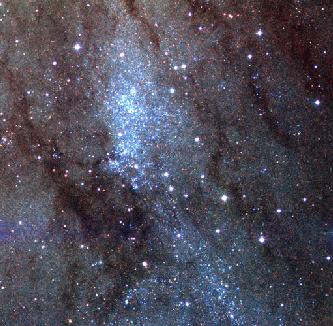Chris Peterson wrote:"Resolved" is sometimes used to describe individual stars seen in other galaxies. In this case, it doesn't mean a star is spatially resolved, but that an individual star is detectable.
ann's usage was clear enough to me. what is the "correct" term for a star that is photographically identifiable as a separate point of light of some finite image scale diameter?
the earlier discussion of galactic and cosmological age was interesting. i'd suggest that we can gain some traction by thinking of galaxies not as evolving one out of the other (e.g., ellipticals out of spirals, like land animals out of fish), but rather as galaxies on a thermodynamic continuum within an arbitrary volume of space, much as we think of different ecologies (e.g., marine animals vs. land animals). the animals that live in the niches are not older or younger, but the ecologies do have evolutionary significance and can be organized chronologically.
"grand spirals" are clearly pulling or have recently pulled gas and dust (and smaller galaxies) from their environment and are dynamically forming stars through the compression of large clouds of gas by gravitational contraction and spiral arm shock waves. ellipticals in contrast are devoid of star forming regions, are dynamically not unlike a perfect gas, are usually surrounded by an enormous cloud of hot gas, are characterized by "population II" stars, are not found at higher redshifts, rarely display supernova explosions, are more commonly found in clusters or groups, can be much more massive than the largest spiral galaxy, etc. ... all that implies that ellipticals characterize a *region of space* where galaxy formation began long before the regions of space where spirals or irregular galaxies appear, especially in isolation. galaxies do not necessarily evolve in a sequence, one type out of another, but they do represent stages in the transformation of matter into stars and the increasingly random balance between gravitation and the second law across multiple megaparsec distances.
supernovae explosions may be necessary for an irregular galaxy to remain irregular, but an equally necessary condition is their low mass. supernovae occur at the same rate in larger galaxies or more compact "starburst" galaxies, but their energies are less in relation to the total angular momentum.
this galaxy has no cutsie name. it's appalling. no one can possibly remember something as arcane as IC 10. i propose we hereafter call it the "cupcake galaxy". or maybe the "buns in the oven galaxy", since it has so many new stars on the way.
 Starburst Galaxy IC 10
Starburst Galaxy IC 10
